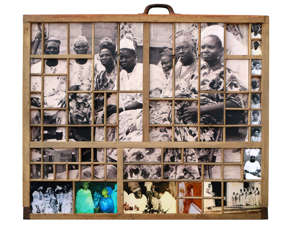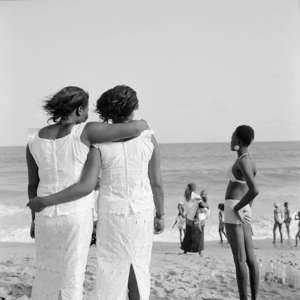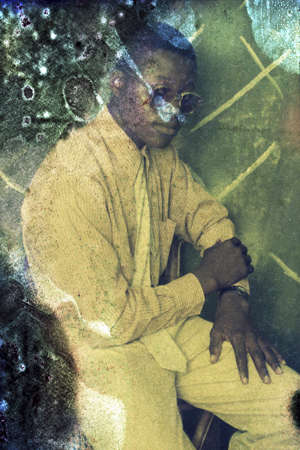[ad_1]

© Provided by ArtNews
Kelani Abass, Unfolding Layers 6, from “Casing History,” 2021.
Despite their authoritative-sounding titles, recent editions of the Museum of Modern Art’s recurring “New Photography” series have grown especially diffuse—too conceptual and too slippery to really make a dent. Here’s the good news: the latest “New Photography” show brings an end to that losing streak. Finally, a “New Photography” with signs of life.
For the first time ever, “New Photography” has a geographic purview. All of the photographers included this time have ties to the Nigerian city of Lagos, otherwise known to Yoruba speakers as Èkó. That alone would make it notable, since African art, and in particular African photography, has rarely been given the spotlight at MoMA.
But the art itself matches the ambitions of the show’s curator, Oluremi C. Onabanjo, who is challenging what it really means for photography to document a city, let alone the people who reside in it. She has made the wise choice to go with just seven artists, a much smaller group than the past two editions of “New Photography.” Doing so allows her to dive deeper into their practices, which each find intriguing ways of paying homage to Lagos’s citizenry and history, in ways both conceptual and not. Guiding all of the artists’ explorations is a fascination with photography itself as a medium—what it does, who it’s for, and what it can reveal.
Logo Oluwamuyiwa, the strongest of these artists, trains his lens on the streets of Lagos, which he sometimes photographs using oblique angles that distort his images beyond recognition. Oil Wonders II (2018) features an upside-down shot of two standing people, one pair of sandaled feet visible at the bottom. Look above them, and a puddle reflecting these people’s top halves becomes visible. He literally reorients our view of Lagos, then does it again and again in an array of prints, vinyl wallpapers, and films shown nearby.
© Provided by ArtNews
Logo Oluwamuyiwa, Oil Wonders II , from “Monochrome Lagos,” 2018.
Oluwamuyiwa’s lush black-and-white photography finds a neat corollary in the work of Akinbode Akinbiyi, an artist roughly half a century older. Working in a mode that’s likewise devoid of color, Akinbiyi turns his attention to Bar Beach, a seaside locale previously popular with Lagosians that has since become a destination for foreigners who can afford it. These photos act as records of what once was, with women lounging, men running, and, in one quaint image, a dog slumbering, seemingly unaware of the bathers around it.
Akinbiyi started this series, “Sea Never Dry,” in 1982, a little over a decade after the Nigerian Civil War ended. His works are serene, mellow, and dreamy, and so, too, are most of the works in this show. But the churning forces of history are still palpable, even in the cases where evidence of them isn’t always visible.
© Provided by ArtNews
Akinbode Akinbiyi, Bar Beach, Victoria Island, Lagos , from the series “Sea Never Dry,” 2006.
Some of Amanda Iheme’s photographs seem at first glance to be archival documentation—they appear to be straightforward pictures of vintage cassette tapes, yellowed public transit tickets, and decaying buildings. Yet pictures such as these represent history that is being lost, especially in the eyes of people who can’t see the erosion taking place.
One of Iheme’s photographs from 2015 features the Casa de Fernandez, a structure built in the 19th century by formerly enslaved people, beneath a sunny sky. It stands unassumingly, its walls streaked with signs of age. The year after Iheme took this picture, the building was demolished under mysterious circumstances. Now, Iheme’s photograph stands as proof that it existed at all.
The past is a fragile thing, a fact underscored by the thin, vulnerable chiffon that Abraham Oghobase uses in his installation Constructed Realities (2019–22). These pieces of silk are printed with centuries-old British texts about “primitive tribes” and the mining of coal in Nigeria; they are then placed atop re-photographed images from the colonial period. Some of those pictures have portions removed, so that the people in them appear to slip away, leaving behind ghostly half-presences.
Similar specters appear in images collected by Karl Ohiri, whose Lagos Studios Archives project has involved amassing old studio portraits and representing them in their damaged state. Many of Ohiri’s scanned and re-photographed images have lost the battle to time—they bloom with unnatural bruise-like splotches and have turned different hues. In their current state, they contain their own haunted beauty. They pair nicely with works by Kelani Abass, whose family’s pictures from decades past are used as raw material for her own work, which sets these snapshots into letterpresses.
© Provided by ArtNews
Karl Ohiri, Untitled, from “The Archive of Becoming,” 2015–.
There’s only one artist here who contributes what’s conventionally understood as documentary photography: Yagazie Emezi, a photojournalist whose work has appeared in the New York Times and TIME. She’s showing works that capture protests against police brutality held in 2020 as part of the #EndSARS movement. These are invigorating pictures that take viewers into the streets, with one featuring a woman who stoically walks between rows of cars while waving a flag.
But the more effective works are the ones which find less obvious routes into Lagos’s roads. In these photographers’ hands, these avenues lead not only to the rest of the city but to the whole of Nigeria—and, ultimately, to many other faraway places.
This much is implicit in Oluwamuyiwa’s Lagos Hosts (2014), a shot of the backside of a dusty bus. Its title comes from a sign in its window: “LAGOS HOSTS THE WORLD.” Oluwamuyiwa has printed this shot as a poster that MoMA visitors can take home for free. Hold on to one of Oluwamuyiwa’s posters, cherish it, and let the influence of this Nigerian hub wind its way into the place you call home.
For more stories like this, follow us on MSN by clicking the button at the top of this page.
Click here to read the full article.
[ad_2]



